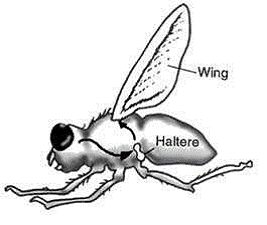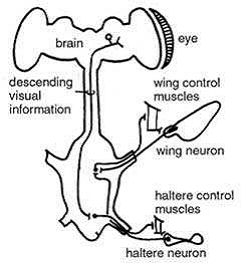Articles
Why a fly can fly like a fly
by Carl Wieland
The humble fly hovering over a garbage can is routinely capable of some high-speed aeronautic manoeuvres that have long boggled the minds of aircraft designers and engineers.
If a male fly chasing a potential mate sees her change course ever so slightly, he will respond with an appropriate change of his own in just 30 milliseconds!
It has long been known that the amazing stability of flies as they zip around has a lot to do with the two tiny club-shaped ‘balancing organs’ they have, called halteres (see Figure 1, right). Some insects have four wings, while others, like the so called ‘true flies’, have two (hence their ordinal name Diptera). Evolutionists believe today’s flies descended from four-winged ancestors, of which the rear two wings have become ‘vestigial’ or reduced in their flight function to become the halteres.

Figure 1. A fly showing one of the clubshaped ‘balancing organs’ or halteres. Arrows show the pathway.
There is of course no scientific reason to deny that the halteres are incredibly well designed, efficient organs in their own right. They have long been known for their function as flight stabilizers, like gyroscopes on airplanes that prevent excessive roll, pitch or yaw. Part of the way this works is that the halteres mostly beat in antiphase to the actual wings. But since such a stabilizing function would tend to make the fly keep flying straight, how does it manage to ‘disable’ this gyroscopic function in order to change course so quickly?
Researcher Dr Michael Dickinson of the University of California at Berkeley, along with a number of colleagues, long knew that flies will perform intricate flight manoeuvres in response to visual stimuli (a fly swatter coming down on them, for instance!). Sophisticated experiments in which flies were tethered in little corsets had shown that images perceived by the fly’s eye-brain system would cause automatic changes in wing activity. Yet a mystery remained, in that for years no one had been able to find evidence of any connecting nerve fibres between the brain and the muscles that controlled the wings.
The breakthrough began when Dickinson was reviewing a much earlier paper that described in great detail some very intricate musculature controlling the halteres. His team then performed more experiments which showed that visual cues while flying did not affect the wing muscles, but significantly affected the muscles controlling the halteres. This suggests that visual information flows directly from the eye/brain to the halteres, not the wings.
The team then demonstrated that stimulating the halteres affects the wing-beat. From all this, Dickinson proposes a much more sophisticated function for the halteres than previously realized. The traditional view has been that as a fly begins to tumble, say, the beating halteres are deflected (by the Coriolis effect), which stimulates some nerve cells long known to be at their base. This then sends the appropriate signals to the muscles controlling the main flight wings.
The picture would now appear to be a great deal more complex (see figure 2). Not only do the halteres send their controlling signals when affected by direct manoeuvres, but a visual stimulus (e.g. an approaching flyswatter in mid-air) will cause information to flow from the eye-brain system to the halteres, which act as a relay station to the main wings.

Figure 2. A fly showing one of the clubshaped "balancing organs" or halteres. Arrows show the pathway.
Far from being an unnecessary detour for the electrical impulses, this makes a lot of sense, says Dickinson. The halteres tend to keep the insect flying in the same direction, so when it has to make a sudden turn, the halteres have to respond as well as the flight muscles. So rather than ‘switching off one’s gyroscope’, the halteres are appropriately fine-tuned or ‘tweaked’ for the required manoeuvre in response to visual cues, a fraction of a second before they in turn pass the information on to the main flight muscles. He says:
“From an engineering point of view, this is much cleverer and more efficient. This way you never turn off your stabilizer—you tune it so the nervous system controls its mechanics on amoment-by-moment basis.”
Also, Dr Cole Gilbert of Cornell University has shown that the relative position of a fly’s head in relation to its body also sends information to the wings and halteres. All this indicates a neural network outside as well as inside the insect’s brain, which is capable of immensely complex and sophisticated tandem actions that eclipse our present technology. Dr Dickinson refers to many remaining ‘puzzles’ about how flies fly, and says he thinks that these creatures are ‘more fantastic and exciting’ than anything ever dreamed up in a science fiction movie.
Summary/conclusion
1. There is no proof that flies evolved from any ‘primitive ancestor’.
2. There is no evidence, either, which forces one to conclude that halteres are ‘vestigial leftovers’ of what were once true (rear) flight wings.
3. Experimental evidence indicates that halteres are part of a highly sophisticated, and immensely complex, flight system which continues to baffle and amaze all who study it.
4. This evidence (as well as that from the fossil record) strongly supports the belief that flies were created as flies, complete with all the necessary sophisticated precision machinery for them to astonish us with their performances.
5. Obviously, at least some of the fly types today function as part of the Curse on a fallen Creation due to Adam’s sin.
References
1. Pennisi, E., 1998. Flying by the seat of their halteres. Science, 280(5361):201–202.
2. Chan, W.P., Prete, F., Dickinson, M.H., 1998. Visual input to the efferent control system of a fly’s “gyroscope”. Science, 280(5361):289–292.
3. Dayton, L., 1998. Can’t hurt a fly? Now science knows why. Sydney Morning Herald, April 14.
4. Highfield, R., 1998. A magnificent flying machine. The Daily Telegraph, April 22, p.16.
5. Anon., 1998. Fossil flies. Discover, 19(8):33.
http://www.creationontheweb.com/content/view/1788
Used by permission of Creation Ministries International: www.creationontheweb.com.
|

